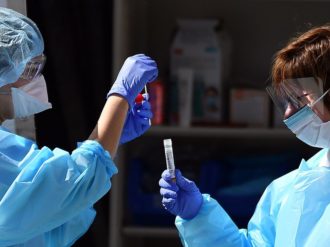A new COVID-19 model from Georgia Tech projects increases of thousands of cases and deaths in the state by mid-August.
The university’s Center for Health and Humanitarian Systems and Health Analytics Group say that depending on how much the public follows physical distancing measures in the coming weeks, Georgia’s total number of COVID-19 deaths could range from 6,100 to 17,900 by that August time frame.
On the peak day, the state could see 44,800 to 77,700 new cases, according to the analysis.
Deaths from the virus currently total 1,360 in Georgia, with more than 32,000 people confirmed as testing positive for the disease.

Pinar Keskinocak, director of the Center for Health and Humanitarian Systems, said the model emphasizes the importance of shelter-in-place and the public’s compliance with social distancing, especially a “voluntary quarantine” when a household member is sick.
The recent reopening of the state’s economy, she said, is expected to lead to increases in cases and deaths. “The peak that we should all be concerned is still ahead of us. The rate of new infections will soon pick up again and increase in the coming weeks,” said Nicoleta Serban, who leads the Health Analytics Group.
The Georgia Tech analysis uses an “agent-based’’ simulation model that the authors say captures the progression of the disease in an individual and also interactions in households, workplaces, schools and communities. It utilizes state demographic data to help arrive at its conclusions.
The model implements different social distancing scenarios, including school closures, shelter-in-place, and voluntary quarantine. The latter is defined as when person shows cold- or flu-like symptoms, all household members stay home until the entire household is symptom-free.

“Our models indicate that if we could achieve very high levels of [voluntary quarantine] compliance, possibly with intermittent shelter-in-place, that would help significantly reduce infection spread,’’ Keskinocak said.
“What happens moving forward depends on what we do,’’ she added. “How we behave makes a big difference in numbers. The primary tool we have now is social or physical distancing, in the absence of a vaccine or antiviral treatment.’’
Other models of the COVID-19 impact on the state also project a significant increase in deaths.
A widely cited analysis from the University of Washington’s Institute for Health Metrics and Evaluation projects 4,913 COVID-19 deaths in Georgia by Aug. 4.
The IHME model is useful for making short-term predictions, Keskinocak said. The Georgia Tech analysis, on the other hand, represents what she calls a “transmission model.’’
“If you are looking for longer-term clues regarding how the pandemic will play out, pay attention to transmission models, even though they have their own built-in uncertainties,’’ she said. “Our model captures the transmissions at a very detailed level, and enables us to do predictions under different potential scenarios.’’
Asked about such model projections, Gov. Brian Kemp said at a Capitol news conference Thursday that “we’re going to continue to follow the data.’’

Models may not incorporate all the social distancing requirements that states have implemented, he said.
“Our numbers continue to look very good,’’ Kemp said, citing a drop in the percent of positives per number of tests.
“I think it’s important for Georgians not to get scared or panic because somebody has a new model that says something,’’ Kemp told reporters. “All models are wrong.’’
Kemp emphasized he can take further action if the pandemic situation worsens in the state.
Weighing different models
The Georgia Department of Public Health said Friday that it considers a number of models, weighing the strengths of each, when trying to estimate the COVID impact in coming months.
The agency said it has worked with the Georgia Tech modelers, as well as those from the IHME, the Massachusetts Institute of Technology and the University of Pennsylvania. Officials have overlaid hospital capacity data by region to anticipate medical need based on these models. These data will be shared with hospitals and health care regions to help them better prepare, said Public Health spokeswoman Nancy Nydam.

The Georgia Tech model predicts that demand for hospital beds would exceed the capacity available for COVID-19 patients in most regions of the state.
Georgia hospitals in recent weeks have increased bed capacity to handle a potential surge.
“Increased testing, contact tracing, social distancing and use of face coverings in public are all steps that are critical to stopping further spread of infection and deaths from COVID-19,’’ Nydam said.
Andreas Handel of the University of Georgia’s College of Public Health said the Georgia Tech study “seems well executed.’’
“The results and conclusions strike me as reasonable,’’ said Handel, who studies the spread and control of infectious diseases. “There is of course uncertainty inherent with any such prediction models.’’
One factor that doesn’t appear to be in the Georgia Tech model, Handel said, is the impact of warmer temperatures on virus transmission.
“However, any weather-related impact is likely not large enough to alter their overall conclusions by a large amount. Overall, I think the results of their study are in the right ballpark,’’ said Handel.
“I believe the idea that we can go back to normal or something close to it at this point is simply not supported by the facts,’’ Handel said. “We need to try everything to reduce transmission further.’’
He cited continued use of shelter-in-place, quarantine, and wearing masks. “And we should also try to ramp up approaches that rely on testing, tracing and isolating individuals.’’

